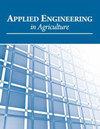Testing Barley Samples for Potential Insect Infestations with a Conductance Mill
IF 0.9
4区 农林科学
Q4 AGRICULTURAL ENGINEERING
引用次数: 0
Abstract
Highlights The conductance mill successfully detected seeds infested with large larvae, over 80% in barley and wheat. Barley seeds, infested with medium larvae, were detected at a lower rate than wheat; ~40% for barley vs. ~65% for wheat. The feed-rate of barley samples was slower than the wheat and the resulting ground barley material contained higher fractions of large particles, over #20 mesh sieve. Abstract. A laboratory mill was developed by Pearson and Brabec (2007) which typically detects 50% to 80% of infested kernels of wheat, brown rice, or popcorn. Barley is another cereal grain of similar size as wheat. Barley is normally sold with its hull attached to the seed, which makes detection of insect infestations more difficult. The objective of this study was to determine the potential of using the conductance mill to detect barley kernels infested by the lesser grain borer, Rhyzopertha dominica (F.), in comparison to detection in wheat. As in previous studies, these experiments found that the conductance mill could detect infested kernels of wheat containing large and medium larvae at a rate of ~90% and ~65%, respectively. For barley, the detection of infested kernels was over ~80% for large larvae and ~40% for medium larvae. Also, we showed that adults that were freely moving throughout the grain mass could also be detected. Approximately ~65% of the adults were detected in wheat while that percentage was reduced to ~35% in barley. The hull on the barley seems to function as an insulator during the conductance measurement and thus reduces detections. Also, the hull seems to affect the feed rate of material through the mill. The feed-rate for wheat was 500 g in 50 s, while the feed-rate for barley was 500 g in ~80 s. Despite these pitfalls, the conductance mill could still be considered as a useful tool with inspecting barley sample, because there was significant detection of insects in the samples and 1000 g sample of barley could be processed in ~4 min. Keywords: Barley, Detection, Rhyzopertha dominica, Sampling, Wheat, X-ray.用电导磨检测大麦样品是否有潜在的虫害
电导磨成功检测出大幼虫侵染的种子,在大麦和小麦中占80%以上。大麦种子中幼虫孳生率低于小麦;大麦为40%,小麦为65%。大麦样品的进料速度比小麦慢,得到的大麦粉料中大颗粒的比例较高,超过20目筛。摘要Pearson和Brabec(2007)开发了一种实验室研磨机,通常可以检测出50%至80%的受感染的小麦、糙米或爆米花粒。大麦是另一种与小麦大小相似的谷物。大麦通常是和种子一起出售的,这使得检测虫害变得更加困难。本研究的目的是确定电导磨检测大麦籽粒受小螟虫(Rhyzopertha dominica, F.)侵染的可能性,并与检测小麦进行比较。与以往研究一样,本试验发现电导磨对含大、中幼虫的小麦籽粒的检出率分别为~90%和~65%。在大麦中,大幼虫侵染玉米粒的检出率为~80%,中幼虫侵染玉米粒的检出率为~40%。此外,我们还发现,在谷物群中自由移动的成虫也可以被检测到。在小麦中检测到约65%的成虫,而在大麦中这一比例降至35%。在电导测量期间,大麦的外壳似乎起着绝缘体的作用,从而减少了检测。此外,船体似乎会影响物料通过轧机的进料速度。小麦投喂量在50 s内为500 g,大麦投喂量在~80 s内为500 g。尽管存在这些缺陷,电导磨仍然可以被认为是检测大麦样品的有用工具,因为样品中昆虫的检出率很高,1000 g大麦样品可以在~4分钟内加工完成。关键词:大麦,检测,Rhyzopertha dominica,取样,小麦,x射线。
本文章由计算机程序翻译,如有差异,请以英文原文为准。
求助全文
约1分钟内获得全文
求助全文
来源期刊

Applied Engineering in Agriculture
农林科学-农业工程
CiteScore
1.80
自引率
11.10%
发文量
69
审稿时长
6 months
期刊介绍:
This peer-reviewed journal publishes applications of engineering and technology research that address agricultural, food, and biological systems problems. Submissions must include results of practical experiences, tests, or trials presented in a manner and style that will allow easy adaptation by others; results of reviews or studies of installations or applications with substantially new or significant information not readily available in other refereed publications; or a description of successful methods of techniques of education, outreach, or technology transfer.
 求助内容:
求助内容: 应助结果提醒方式:
应助结果提醒方式:


